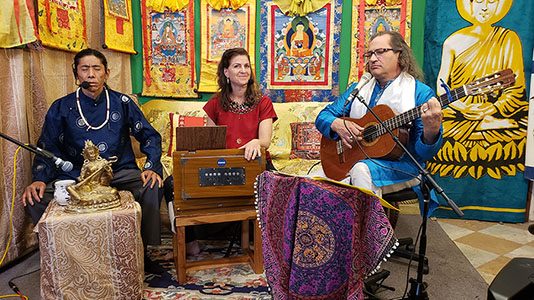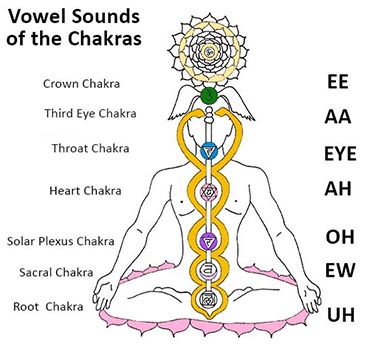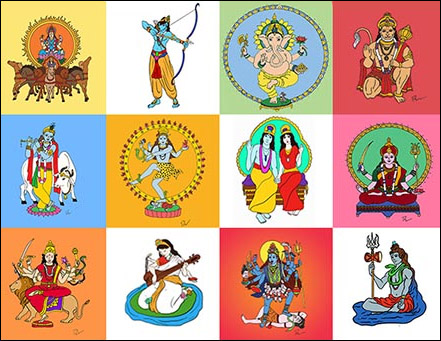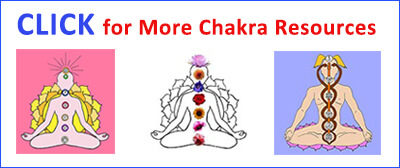
What is a Mantra?
A mantra is a word or term of power. Every mantra has a specific and exact potency. The word “mantra” is derived from two Sanskrit words. “Man” is from “manas” or mind. “Tra” is from “trai” meaning to protect or free from. Ultimately, the idea is that a mantra will free the seeker from the limitations of the mind.
This article covers several aspects of mantras including how to use a mantra, the Hindu pantheon, the music of India, the value of kirtan, building a mantra, and the use of Sanskrit. For additional coverage of related topics, see the book Vocal Medicine: Transformation through Sound.
Share this page with a friend!
Watch nearly 400 videos on the Vocal Medicine Channel!
Mantras and the Power of Sound
In English, the words “chant,” “enchanted” and “incantation” are closely related. Using a formula of words to change matter through a “spell” has often been depicted in the realm of magic. This has recently been brought to mainstream consciousness courtesy of J.K. Rolling’s Harry Potter series.
This principle holds true for both constructive and potentially harmful uses of language. There are curses or spells on the potentially negative side. Then there are constructive uses of language including prayer and mantras on the positive side.
Levels or Types of Mantras
Mantras are types of worded formulas or sound tools with distinct impacts on emotional, mental and spiritual states. The term “mantra yoga” is simply a name for using mantras as a spiritual practice, much like meditation or hatha yoga poses. In yogic philosophy, there are three levels of mantras depending on the practitioner’s intention:
Liberation Mantras (Sattvic): The intention is for the fulfillment of the soul’s desires, spiritual liberation, service to all, and provision for basic needs (shelter, food, security).
Achievement Mantras (Rajasic): The intention is to accomplish outer goals in life such as wealth, career, power, relationships and prestige as if they were the highest needs.
Controlling Mantras (Tamasic): The intention is to control, harm or hypnotize others in a destructive or ignorant manner (voodoo, black magic, witchcraft).
Are Mantras a Form of Yoga?
Mantras are types of worded formulas or sound tools with distinct impacts on emotional, mental and spiritual states. The term “mantra yoga” is simply a name for using mantras as a spiritual practice, much like meditation or hatha yoga poses.
Mantra Practice
Mantra practice has powerful effects on the body, mind and consciousness. Scientists are studying these effects on individual well-being on many levels. Mantras can help to remove deep-seated emotional patterns and karmic blockages from the mind and heart. This process may result in psychological, emotional, and physical healing.
Bhakti Yoga
The Eastern form of devotional singing is known as mantra yoga or bhakti yoga. This is a branch of yoga that focuses on devotional practices. The power of the voice for transformation is evident. This may be one of the reasons why devotional singing exists in virtually all cultures and religious traditions.
Universal Mantras
Every language and word expresses a particular vibration as well as conscious meaning. An example of a mantra in English is “Gloria in Excelsis Deo” meaning “Glory to God in the Highest.” Another example is the Hebrew phrase “Shalom Aleichem” meaning “Peace be with you.” Learn more about the Hindu or Ayurvedic healing tradition in Healing Mantras. Or discover the power of One Word Mantras.
Mantras and Nada Yoga
“Nada” is the Sanskrit word for sound or tone. The entire universe consists of sound and vibration. The flow of sound that changes matter. “Yoga” means to unite, connect or integrate. Yoga is the union of polarities: mind and body; spirit and matter; masculine and feminine.
Nada Yoga and Bhakti Yoga
Nada yoga or the yoga of sound is a central part of Bhakti Yoga. Bhakti yoga is the path of devotion or the path of the heart. Much of this path is focused on singing the praises of God in one form or another. Chanting is a form of singing which utilizes sound, voice, rhythm, and melody to express love.
The Legend of Golem
There are legends in many cultures about the miraculous power of spoken commands. For example, a “golem” is a creature in Jewish legends that is created from mud or clay. The creature is then animated by inscribing a holy word on its forehead or by singing passages from scripture. Through extended periods of chanting, the clay creature could be given life.
The Language of Mantras
Mantras are part of the technology of generating mystical experiences. Sacred toning and chanting generate large amounts of energy that can be qualified or concentrated for a particular purpose. As a general principle, chanting can be done is any language.
Sacred Languages
However, a few of the languages viewed as particularly appropriate for sacred mantras are Sanskrit, Hebrew, Greek, Egyptian, Tibetan, Gurumukhi, and some Native American languages. Some mystics also consider English to be closely aligned with angelic tongues.
How to Use a Mantra
A mantra is like a tagline for your life as a whole or for an aspect of your life. A mantra was once something given by a spiritual teacher to a disciple. Although you may still decide to find or be given a mantra in that tradition, you can also choose your own mantra or multiple mantras that are beneficial for your life.
The Energy of Mantras
A mantra is a word or phrase with a specific and exact energy. In the colloquial sense, we are surrounded by mantras all the time. The taglines of businesses serve as mantras for their success. Common examples are “Just do it” (Nike), “A diamond is forever” (DeBeers) and “You’re in good hands” (Allstate Insurance).
Frequency of Mantras
A well-chosen mantra is an affirmation that keeps you on course in whatever is the highest direction or highest aspiration for your life. Every mantra carries a vibration or frequency, giving them a certain amount of power in and of themselves. However, the energy of the mantra is also directly related to the intention and focus of the one who is chanting.
Reciting a Mantra
Mantras can be recited mentally, spoken aloud or sung. If you are looking for changes in your inner and outer circumstances, mantra yoga is a very powerful tool! If you want to change your financial condition, consider focusing on a Wealth Mantra. For healing on all levels, explore the Medicine Buddha Mantra.
Mantra Yoga and the Hindu Deities
Mantras focused on the names of the gods and goddesses in the Hindu pantheon appear to be coded compilations of sound designed to create elevated states and to stimulate health and longevity. The entire universe consists of sound or vibration. The rishis of India (Hindu sages) experimented for thousands of years with the effects of mantra yoga.
Deities of Hinduism
The gods and goddesses of Hinduism can be viewed as parables, mythology or as legends based on the lives of ancient historical persons. Perhaps the most significant aspect of the process of relating to a god or goddess is the sense of a personal relationship. They do exist at some level whether that be psychological, spiritual or factual.
Heroes and Heroines
Every tradition has heroes and heroines that are examples which others can emulate. In some cases, their stories are cautionary tales of pitfalls to avoid. They are like us in many ways. They are often grouped in families. They have consorts and relationships with other divine beings.
Memorable Stories
In addition, their stories are often fantastical, making them highly memorable. Mantras are keys to connecting and embodying the aspect of God’s consciousness exemplified by a particular deity. They also appear to be very practical forms of yoga for youthfulness and health.
Chakra Gods & Goddesses
There are also Hindu deities that are associated with each of the seven major chakras or energy systems in the body. A brief outline of these deities and possible mantras are given below. For more information, please read the extended article Chakras and Deities.
The Use of Mantras in Kirtan
Our brains are wired for what some scientists call “regular irregularity.” The human eye and ear are designed to notice and pick up small variations in the environment like leaves rustling in the breeze.
Engaging the Brain in Mantras
One of the wonderful things about kirtan music is the ever-changing nature of singing a mantra or chant. The same simple chant is never exactly the same. There are always slight differences with each repetition that occur naturally. Those small variations keep the brain engaged.
Variations in Mantras
The pitch of one or more of the voices may be slightly different. The rhythm may vary a little bit. This creates variation within given parameters that allows for ongoing interest while maintaining comfort and stability participating in kirtan music.
Do Mantras Have to be in Sanskrit?
The rishis of India (Hindu sages) experimented for thousands of years with the effects of chanting and sound. Mantras are believed to be coded compilations of sound designed to stimulate health and longevity as well as to create elevated mental and spiritual states. For example, the sound “uhm” is purported to energize and purify the blood. The sound “aha” is stimulating for the hormonal system.
The Sanskrit Effect
These sounds are particularly prominent in Sanskrit, the most common language used in kirtan music. The positive impact on the brain of learning mantras is being referred to by neuroscientists as the “Sanskrit effect”. Science is showing that the ancient practice of chanting is akin to yoga and meditation and possess an equivalent or possibly even greater healing power for the body, mind and spirit.
Kirtan Music
Kirtan music repertoires may be specific to unique traditions, such as the chants associated the Vedic mantra tradition or kundalini yoga. Those chants would typically be in Sanskrit or Gurmukhi (a Sikh language). Kirtan music may also include chants from a wide variety of traditions and in a wide variety of languages.
The Language of Kirtan
Typically, kirtan music in the West is focused on Hindu or Buddhist traditions in Sanskrit. However, Christian chants in English as well as chants in Hebrew or any other language are possible. In fact, including chants in the native language of participants can be a great comfort.
Plasticity of the Brain
This is similar to what has been revealed through neuroscience: an injured brain creates new connections and pathways to restore full functioning. This process actually increases the plasticity of the brain. The connections in the heart are like the new neurons in the brain, or like the seams of welded steel that mend a sword, but they are flexible and soften the heart rather than making it more rigid.
Mantras and the Science of Cymatics
The work of Hans Jenny and others involved in the science of Cymatics demonstrate that forms are created by various tones and sounds. Cymatics is the process of recording the patterns formed on plates or drums covered with sand or crystals. Ancient symbols and geometric symbols emerge when sound passes through the chosen medium. Others are photographic the forms created when sound passes through water.
Creating Forms through Sounds
Sound is a direct conduit between the world of spirit and the world of matter. When we speak and especially when we sing (due to the added emotional energy), we are creating forms. These forms are harmonious or dissonant based on the sounds we are making. This is a divine science and a lifetime study. The use of a mantra can focus the sound repeatedly on a positive pattern.
Mantras and the Celestial Body
In addition, there is a concept in Christianity as well as other traditions that our practices while in a physical body are also creating an eternal body. In the Bible, this is called the “body glorious” or the “body celestial.” The practice of mantras and other spiritual practices may be creating an energy field that goes beyond the physical body into other dimensions.
The Aura and Human Energy Field
For example, the aura is an energy field extending beyond the physical body. The physical body exists within this field and is affected by the aura. Mantras, sound, meditation and so forth can create a protective shield around the physical body. This energy field may be directly affected by repeated chants as well as visualization.

Building a Mantra
The impact of vowels and consonants on the body and the mind is an amazing science. There appears to be a coded formula in many sacred languages that directly stimulates various systems and organs in the body. There are also mudras (hand positions) and body movements that correspond to each note of the scale.
Energy of Vowels and Consonants
At a fundamental level, vowels are feminine energy: consonants are masculine energy. Vowels are generic and formless. Consonants set parameters around the feminine energy to create form from formlessness. In other words, consonants create a container.
Author Kathleen Karlsen
Kathleen Karlsen is a musician, artist, writer and speaker. She is the author of two books (Flower Symbols and Vocal Medicine) and over 200 articles. Kathleen, her husband Andrew, and their five children live in Bozeman, Montana. More about Kathleen Karlsen.
SANSKRIT MANTRA ARTICLE SUMMARY
This article on Sanskrit mantras includes how mantras affects the brain, the impact of different languages when singing and the power of group singing. Includes videos related to Sanskrit mantras.
Click for all content on our Site Map
Share this page with a friend!
Watch nearly 400 videos on the Vocal Medicine Channel!
![]() Vocal Medicine Music on Spotify!
Vocal Medicine Music on Spotify!









